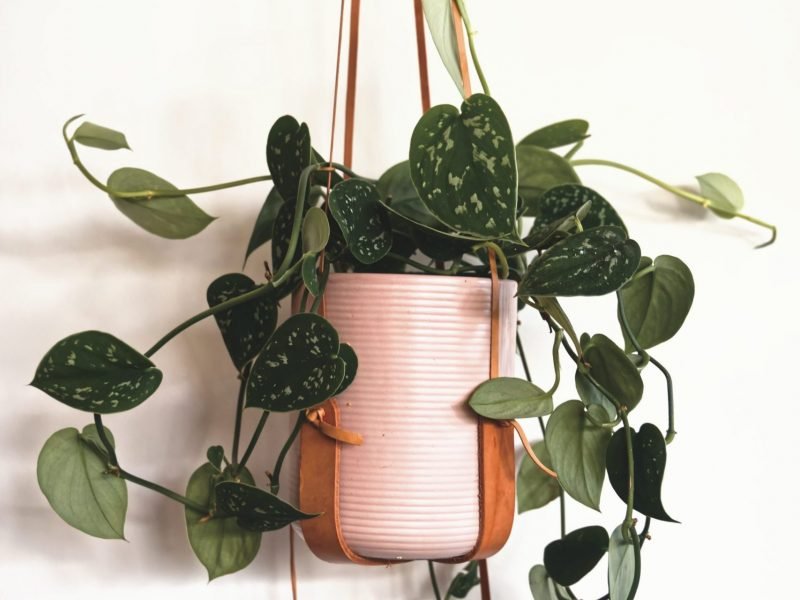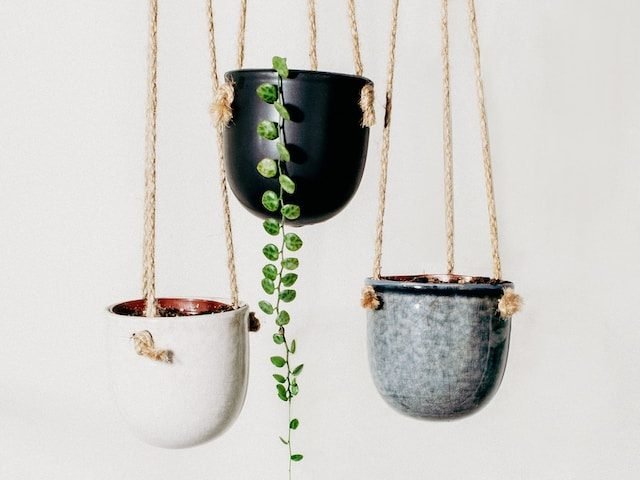
Curling leaves can sometimes be a tricky problem for a plant parent to have because there are quite a few possible causes. In this post, you will find all of the most common reasons why your Satin Pothos has curling leaves. It’s important you go through one by one to find out what is causing it so you can fix the problem as soon as possible.
Underwatering can cause curling leaves
Issues with watering are the number one cause of plant problems, and curling leaves are no different. Consistent underwatering will mean your Satin Pothos’ leaves will begin to curl as they go into shock and shrivel up. Although Satin Pothos plants don’t like to have really soggy soil, they aren’t drought tolerant. Curling leaves is often one of the earlier signs of trouble when it comes to a lack of water. It’s your plant’s first defence against water loss through its leaves which means if you act now, you’ll have quite a good chance at solving the issue before it starts to cause any real damage.
Before you go and drown your Satin Pothos with water to make up for the lack of it, you want to be certain that this is the problem. Watering a plant when it really doesn’t need it will cause a whole range of other issues. To confirm the diagnosis, take your Satin Pothos out of the pot to inspect how the potting mix feels. If underwatered, the potting mix will fall apart and feel very sandy. We also recommend that you take a look at the root system on your plant as if the roots have started to crisp up, then this tells you that the problem has been going on for a while.
To fix the issue of curling leaves (and prevent more problems from developing) slowly reintroduce water to your plant rather than drowning it. Any dramatic and sudden changes in their environment can cause your Satin Pothos to go into shock (they can be a little bit sensitive so just be cautious).
To avoid curling leaves in future, use a moisture meter to monitor how moist the soil is before you water it. Although you want to give the potting mix time to dry out between waterings, you don’t want it going too long without a drop. Moisture meters are super affordable and will help with your other houseplants too so are a great investment.
Overwatering and root damage can also be causing the leaves to curl
Much like underwatering, too much water can also make your Satin Pothos curl up. Whilst they can often deal with the occasional overwatering as they have quite robust root systems, they will start to struggle if the potting mix is really waterlogged. Curling leaves is also one of the earlier signs of overwatering so it’s best to treat the issue now before it progresses into something a lot more serious.
If your Satin Pothos’ roots begin to rot they won’t be able to take up any water or nutrients from the soil. This starves the plant of vital resources for growth and the leaves may begin to curl. They will also likely turn soft and yellow so watch out for these signs too.
Like with underwatering, you want to be sure of the problem before changing how much you water. Waterlogged soil can be pretty easy to diagnose so just using the finger or chopstick method should help you to figure it out. Overly soggy soil also gives off a really bad smell so this is also something to watch out for.
If you have been overwatering your Satin Pothos then it is important that you act quickly to stop the problem from causing more permanent problems beyond curling leaves. Replace any waterlogged soil with fresh dry mix and trim away all rotten roots. They can’t be saved so it’s best to remove them entirely.
The next thing you need to think about is stopping the issue from causing more curling leaves in future. You either need to cut back on how frequently you are watering your Satin Pothos, or give it less water each time you do. Either of these options works so figure out what works best for your plant and your routine. You also need to take into account changes in environmental factors that might affect how much water your Satin Pothos needs. Cut back on watering during winter months for example.
Curling leaves can indicate overfertilisation
Another cause of curling leaves on a Satin Pothos is over fertilisation. We recommend fertilising using a water-soluble fertiliser at lower than recommended strength every month or so during spring and summer. Every single houseplant is different and there are a lot of factors that play into the decision of how much to fertilise; size, maturity, location are just a few. This is why there could never be a one-fits-all amount to feed each plant like it often suggests on the bottle. Using less than the recommended amount can help to avoid overfertilisation.
You also want to hold off giving any fertiliser during the winter months as your Pothos will not be producing any new growth.
If you are fertilising more often, then it may be the cause of the curling leaves. Replace the potting soil and reduce how much you are fertilising. You can even leave it out completely if you want to – it’s sort of an added extra and better to skip it than cause more harm.
Light levels can be a factor in curling Satin Pothos leaves
The wrong amount of light is also a cause of curling leaves in Satin Pothos plants. Both too much and too little light will make the leaves curl but luckily there is a simple way to find out which it is.
If your Satin Pothos is receiving too much light, the leaves will curl inwards. This is how the plant protects itself against the intense light. By curling inwards it is reducing the surface area that the sun is hitting. Direct sunlight will also very quickly scorch and burn the leaves of your Satin Pothos which is, unfortunately, irreversible so look out to see if you can see any burnt spots on the leaves that might indicate sun stress.
If you think that direct sunlight is the cause of the curling leaves on your Satin Pothos, move your plant to a slightly shadier spot in your home and monitor any changes.
However, if your Pothos plant is not getting enough light then the leaves will also curl up but this time they will curl upwards in the direction of the light source. This is how the plant tries to increase the amount of sunlight hitting the leaf. If this is happening to your Satin Pothos then you want to find a spot that receives a little bit more light to aid with healthy growth.
Be careful of temperature fluctuations
Even if your Satin Pothos isn’t getting direct sunlight, if the temperature is too hot, your Satin Pothos may start to curl its leaves. This is called heat stress. Hotspots in rooms caused by sunlight, radiators or cookers can mean that the temperature is a lot hotter in a small spot of the room. It makes it difficult to notice as you may find the overall room temperature to be perfectly fine!
Make sure you move your plant at least 1 metre away from any radiators, heating vents or cookers to prevent overheating and curling leaves. We also recommend using a digital thermometer to monitor any extreme temperatures or any fluctuations. This will help you decide if you need to relocate your Satin Pothos to solve the issue of curling leaves.
Curling Pothos leaves can also indicate pests
This is quite a rare cause as Satin Pothos plants don’t often get attacked by pests but an infestation of scale insects, spider mites or mealybugs may be causing the leaves to curl. Get up close to your Satin Pothos’ leaves using a magnifying glass and inspect the tops and undersides of the leaves to see if you can spot any insects. If you do spot any insects, or any signs of them, then you want to isolate your plant from all of your other houseplants immediately. Pests can jump across plants through leaves that are close so give all of your plants a look over to see if the infestation has spread.
You then want to remove the worst affected leaves to cut the size of the infestation as this stops it from growing as rapidly and makes it a little easier to treat. Shower your plant regularly and treat with neem oil and insecticide to fight the infestation.
These are the most common reasons why your Satin Pothos may have developed curling leaves. We always start by checking the soil’s moisture as watering issues are often the reason, before eliminating the rest one by one.
If you want to find out more about how to care for your plant, check out our Satin Pothos care guide.















